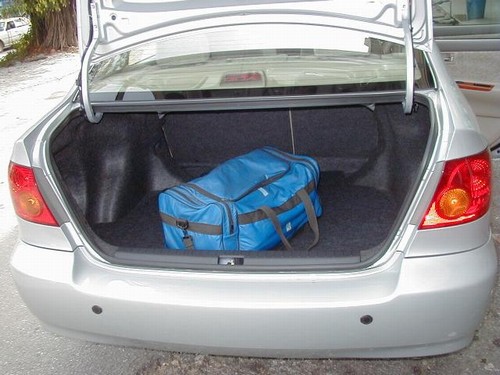Page 4
So far, the features mentioned come under Passive Safety – the protection offered when an accident does occur. There is also Active Safety which concerns the features that help the driver to avoid an accident. These include good all-round visibility, brighter lights and even the prominent third brake light. However, with the Altis, standards of Active Safety have been raised for this class of cars and it is a clear leader.
For starters, it has disc brakes front and rear and while that may be commonplace in the Proton Waja and Wira, it seems to have taken a while to come to the other models in the same class. Then there is ABS which is now standard and enhanced by Electronic Brake force Distribution (EBD). This additional feature works by optimizing the brake force on each wheel. This is important because loads in the car may vary and dynamic forces will also differ during cornering. EBD distributes the force applied to the front and rear brakes according to the conditions so there is more stable braking. It can also control the braking of the right and left wheels separately to ensure that braking during cornering is stable.
Research has shown that most drivers do not apply optimum pressure on the brake pedal during an emergency. There are also drivers whose legs may not be able to depress the brake pedal to the full extent while older drivers may lack the strength to apply great force. Thus the full capabilities of the brake system are not used and to address this, Toyota developed Brake Assist (BA). With BA, a computer monitors the brake pressure applied as well as the speed of pedal depression. If the condition is that of emergency braking, a signal is sent to the brake system to boost the pressure to the brakes. Tests by Toyota have shown that BA can shorten braking distance by between 10% – 15%.
Those who buy the Altis 1.8G also get Vehicle Stability Control (VSC) and Traction Control (TRC). This is a big surprise because VSC only appeared in Toyota models about six years ago and until now, its availability has been restricted to the expensive models like the Crown and Lexus. Considering how long it has taken ABS to reach the Corolla class, the introduction of VSC in this class today is certainly ahead of time!
VSC helps control lateral skids on slippery or dry road surfaces by detecting and correcting understeer and oversteer conditions. Working in tandem with TRC, the system provides the driver with a higher level of active safety and could make the difference between safely getting around a curve on a rainy day or ending up in the drain. Like ABS, it doesn’t enable higher cornering speeds or allows drivers to perform like Michael Schumacher and is intended to help them get out of trouble. More on VSC
Also listed under ‘safety features’ is a reverse sensor which is a dual-cell type for better coverage, especially against objects like plants, and a fuel pump that is designed to shut off fuel flow when the engine stalls or when the airbags deploy.
continued on page 5


























